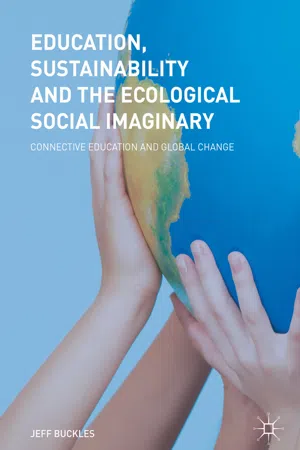1.1 Locating the Argument
This book takes a ‘what if’ approach; it is utopian ; it is unashamedly academic; and it has a specific position.
This book sets out a ‘What if’ approach. It looks at what education might look like if we perceive it from an ecological perspective. At the end of Chap. 6 I identify five responses to the environmental challenges humankind might be facing: despair, ignore, reject, adapt and transform. The adapt response tends to lead towards a technocentric perspective, and this has been discussed at length (The Royal Society 2009; Brand 2009; Thornes et al. 2014). I wanted to take the transform path, and ask What might it be like? In this way I am looking at some basic questions – Where are we now, where do we want to go to, how will we get there? I build my premise upon analysing where are we now? and from there move to where do we want to go to? It is this that I explore and develop in the second half of the book. There is very little discussion of how will we get there, because I see that as a practical outcome of the discussion about where we want to go to. It is this latter question, and the discussion around it that fascinated me, and my hope is that this book may stimulate the discussion around this theme.
Chapters 3 and 4 take us from the past into the present, by looking at how humankind’s thinking has changed over the last three hundred and fifty years, and the part that education has played in this. Chapters 5 and 6 look at the present and begin to look towards the future by examining the evidence for global change , and the different ways in which humankind can respond to those. Chapters 7 and 8 begin the journey into the future, by asking how humans need to change their thinking if they are to avert some of the possible dangers outlined in Chap. 5, and also what education might look like if humankind can change the relationship it has with the planet upon which it lives and depends.
This book is utopian , in the way that Bussey and Inayatullah (2008: 3) identify utopias as alternative futures, so that humankind can then choose different futures (deGeus 2002), rather than just be swept along by forces seemingly beyond their control. Wright (2010: 25) locates utopias within ‘emancipatory social science’, what he defines as ‘a theory of a journey from the present to a possible future’. This has three elements: a ‘diagnosis and critique of society’ which identifies why humankind would want to leave their current world; a ‘theory of alternatives’, which identifies where they would want to go; and ‘a theory of transformation’, which tells them how to get from the current to the transformed world (Wright 2010: 25). This book is located within the first two elements that Wright identifies, with Chaps. 3, 4, 5, and 6 consisting of diagnosis and critique, and Chaps. 7 and 8 outlining an alternative.
For Levitas (2013: 84), models of utopia ‘are explicitly holistic, imaginary, critical, normative, prescriptive and (often) future-orientated.’ They have three modes: archaeological, which critiques ‘images of the good society’ in current policy (Levitas 2013: 153); ontological, which looks at the type of person that will be developed; and architectural, which is about ‘the imagination of potential alternative scenarios for the future’ (Levitas 2013: 153). This book focuses upon the architectural, with aspects of the ontological. The former is about imagining ‘alternative ways of life that would be ecologically and socially sustainable and enable deeper and wider human happiness than is now possible’ (Levitas 2013: 153). In this way, by identifying the key aspects of a utopian model, they are ‘open to scrutiny and to public critique’ (Levitas 2013: xvii).
This book is academic, not in the sense of being obscure or using jargon, but in the sense that it is fully referenced. This is for three reasons. Firstly, in a ‘post-truth’ world, which is just a euphemism for lying (Levitin 2017), it is important that readers can see where my arguments and data are from, and what I have done to them to arrive at the conclusions that I do. Secondly, when there is a concerted political resistance to the application of science to climate change (Lawson 2006; Hansen 2009), it is important that the reader can see where my data has come from, who I have read, and how I have used their arguments; and thirdly, by fully referencing I acknowledge my debt to those who have made this journey before, and it enables those who wish to continue the journey, or to veer off, to see where they may go.
This engagement locates this book as being about a shift of consciousness that Sterling (1996: 29) terms as ‘radical ecologic’. This foregrounds the argument put forward in this book that it is paramount that humankind shifts from its current consciousness to a new one, which is mapped out in Chap. 7. For Sterling (1996: 29) the radical ecologic necessitates seeing the Earth as a system, that human activity can affect that system, that there is only one Earth, and through ecological design humankind can engage in personal and species transformation.
Finally, a mention about education . How humans arrange education (the how, what, when, why and where of learning), reflects the type of society they live within. Education within this book is seen as forming , legitimating and perpetuating a particular society, so that societal change (Macy’s shift in consciousness) occurs before educational change: so...
